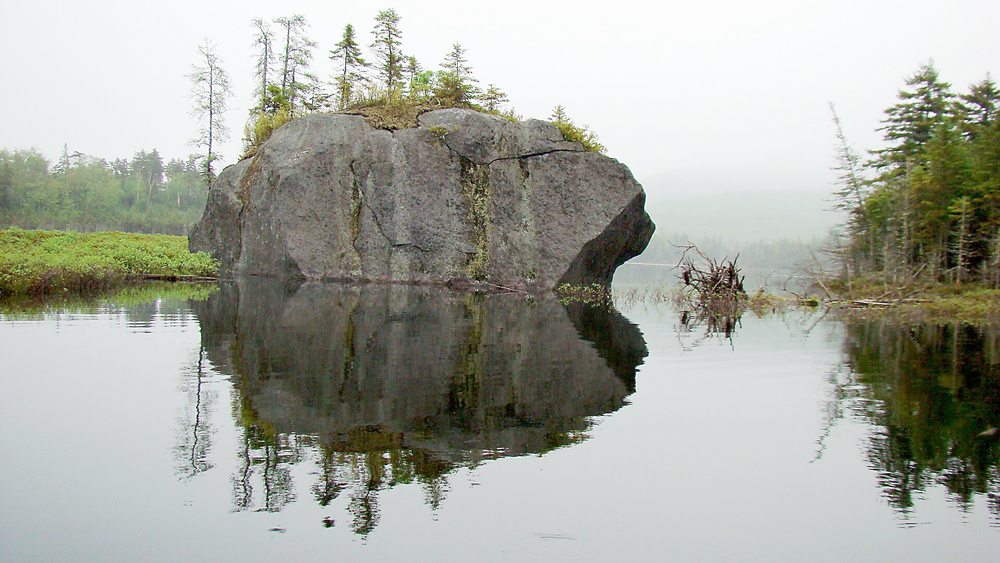Cheers, tears and hear-hears after Boreas classification

A large glacial erratic looms large amid the still waters of the Boreas Flow. (Provided photo — Joe Hackett)

Snow conditions have been nearly ideal for skiing and snowshoeing, even though plummeting temperatures and mind-chilling windchills have made long jaunts more challenging than usual.
However, I prefer snow and ice to rain and slush. Once you’ve learned how to thoroughly enjoy snow, ice and cold weather, the winter season often passes through too soon.
With safe ice on the lakes and ponds, and a solid snowpack in the woods, current conditions are quite nice in the backcountry. A fast base, topped with fresh powder makes for quick and easy travel, especially for pond hopping through the Fish Creek and St. Regis Canoe areas.
In addition to the ongoing celebrations surrounding the annual Saranac Lake Winter Carnival, there has also been a mix of cheers, tears and hear, hears that accompanied the classification of lands that were involved in one of the largest land deals in the history of the Adirondacks.
The lands, which have been used for the forest products industry and forest recreation, are located primarily in southern Essex County, spread out among several towns.
The recently purchased lands are largely composed of a historic old tract that has served as the home base of several hunting clubs, including the Gooley Club, which is a venerable old hunting, fishing and outdoor recreation organization. The sale and recent classification of lands include the 18,318-acre Essex Chain tract, Vanderwhacker Mountain Wild Forest and the 944-acre Outer Gooley Club tract.
The centerpiece of these land deals was Boreas Ponds, which, according to the Adirondack Park Agency website, includes seven waterbodies, 27 miles of pristine streams, 1,800 acres of high value wetlands including the state’s largest high elevation peatland: the 1,200-acre Marcy Swamp. There are three named peaks over 2,000 feet: Boreas Mountain (3,776 feet), Moose Mountain (2,700 feet) and Ragged Mountain (2,677 feet).
Based on its natural resources, the Boreas Ponds Tract has the potential for strong resiliency to climate change impacts and is a key parcel on the local and regional scale for ecological connectivity.
Lands classified as Wilderness were a point of contention during the APA’s recent approval process. The resulting compromise left intact a primitive corridor which will allow for the maintenance and repair of an existing concrete dam that impounds the Boreas Ponds.
DEC will develop Unit Management Plans to determine public use of the lands. Wilderness lands around the Boreas Ponds will be added to the High Peaks Wilderness and Wild Forest lands will be added to the Vanderwhacker Mountain Wild Forest area. Once completed, the inclusion of new lands will more than double the current size of the High Peaks Wilderness Area.
Despite the vast nature of the property, it is far from wild. The land has been harvested for natural materials for more than a century, and it bears the scars of such use.
However, nature is very resilient. It’s inherent beauty works fast to remove the thumbprints of man. I expect the land will rapidly patch up man’s handiwork and make room to allow nature to flourish.
However, for the folks and families that have shared the surrounding woods and waters, nothing can be said to alleviate the sadness that comes with the realization that they have lost their camps. A simple cabin in the deep woods provides far more than a roof over your head and a woodstove at your feet.
It is akin to losing a family member. It is a place where boys often became men, and where men were surely allowed to be boys, at least for a weekend. A camp provides more than a simple retreat, it offers peace of mind, where we can escape the “real world” for a week or just a while.
For many enthusiasts and their families, the sting of losing their camp will linger, often for generations. While the camp is important, it is the land that matters. Former members of the clubs likely know those woods and waters like the back of their hands. It is an intimacy that is only achieved with long hikes, silent watches and putting boots on the ground.
I’ve gone down the same path twice in my career, and it never helps to look back. While the old club members will surely lament the loss, they are safe with the knowledge that they know the “lost land” like no others. It is bittersweet comfort that can easily be erased by “tipping one over” next season on a deer runway that was only known to you.
As APA Chairman Sherman Craig explained, “The Boreas Ponds classification is a generational opportunity to find harmony for wilderness solitude, backcountry recreation and appropriate public access to a stunningly wild place that ensures people of all abilities and interests may experience the sense of wonder and discovery which are the defining characteristics of the Adirondack Park.”
I certainly applaud the cooperation of the various towns involved, as well as former Adirondack Nature Conservancy director Mike Carr and his staff for their patience, dedication and energy. It was a long and complicated project, and the combined efforts of everyone involved will bear fruit for generations to come.
Although the Boreas tract was developed for the harvest of lumber and pulp wood, the property provided generations of sportsmen and women, as well as their families and friends, with a home away from home.
The property would not be what it is today without their commitment, care and concern. They treated the land like it was their own, and in a special way it will always be.
However, there will be no way to escape the fact they’ve lost a piece of their heart in the process.



